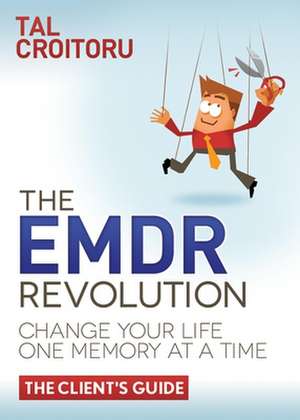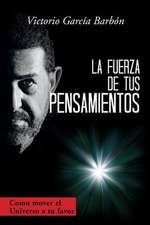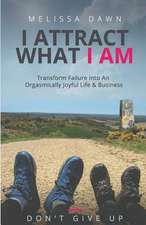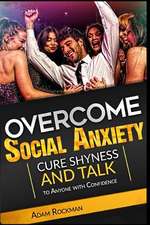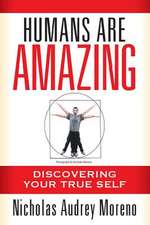The Emdr Revolution: Change Your Life One Memory at a Time (the Client's Guide)
Autor Tal Croitoruen Limba Engleză Paperback – 31 dec 2013
Have you been experiencing negative feelings for a significant amount of time, or are you experiencing negative feelings as the result of a crisis or traumatic event that don’t seem to pass on their own?
Do you feel that you have internal obstacles that prevent or inhibit you from advancing and breaking through, even though in theory you know what needs to be done?
Have you noticed that you exhibit patterns of behavior that hinder you in your personal or professional life that awareness alone does not prevent you from repeating?
Do you have unpleasant feelings, fears, or concerns that prevent you from speaking before an audience, cause you to feel uncomfortable being the center of attention, and block you from advancement in your personal or professional life?
The good news is that this condition is reversible.
Even better news? Through a novel form of psychotherapy called Eye Movement Desensitization and Reprocessing (EMDR), the rate of change is faster than ever thought possible.
For example, did you know:
• EMDR is a psychotherapeutic treatment that yields meaningful results within weeks in cases where other methods take months or years to go into effect? Many studies confirm the effectiveness and success of the method within just a few therapy sessions
• Millions of people have already successfully been treated by this method
Inside The EMDR Revolution you will discover the important information you need when feeling distressed or inhibited, as a way to select the appropriate help.
Reading the personal stories contained within will teach you a lot about yourself—what affects you, what motivates you, and what limits you. You deserve a better life. EMDR can help you heal your life, one memory at a time, and live the life you were meant to live.
Why EMDR?
-There are only three evidence-based therapies for trauma: prolonged-exposure therapy (PE), Eye Movement Desensitization and Reprocessing (EMDR), and cognitive behavior therapy (CBT). EMDR was found to help in fewer sessions and does not require homework between sessions, making it the fastest evidence-based therapy there is. It is the classic treatment for veterans and those suffering the effects of traumatic events such as hurricanes and other forms of devastation.
-EMDR is a great supplement for personal-development. After recognizing your limiting beliefs, with EMDR you can reprocess them so you don’t need to keep fighting them, and you can free all your energy towards the future.
-We are mistakenly told that there is nothing we can do to change the past, so we need to ignore it and concentrate on the present. But this is not true. The past “hunts” us via our memories. With EMDR we can change the way our past is stored in our brain—and thus the way we are influenced by it—allowing us to change our life one memory at a time.
Do you feel that you have internal obstacles that prevent or inhibit you from advancing and breaking through, even though in theory you know what needs to be done?
Have you noticed that you exhibit patterns of behavior that hinder you in your personal or professional life that awareness alone does not prevent you from repeating?
Do you have unpleasant feelings, fears, or concerns that prevent you from speaking before an audience, cause you to feel uncomfortable being the center of attention, and block you from advancement in your personal or professional life?
The good news is that this condition is reversible.
Even better news? Through a novel form of psychotherapy called Eye Movement Desensitization and Reprocessing (EMDR), the rate of change is faster than ever thought possible.
For example, did you know:
• EMDR is a psychotherapeutic treatment that yields meaningful results within weeks in cases where other methods take months or years to go into effect? Many studies confirm the effectiveness and success of the method within just a few therapy sessions
• Millions of people have already successfully been treated by this method
Inside The EMDR Revolution you will discover the important information you need when feeling distressed or inhibited, as a way to select the appropriate help.
Reading the personal stories contained within will teach you a lot about yourself—what affects you, what motivates you, and what limits you. You deserve a better life. EMDR can help you heal your life, one memory at a time, and live the life you were meant to live.
Why EMDR?
-There are only three evidence-based therapies for trauma: prolonged-exposure therapy (PE), Eye Movement Desensitization and Reprocessing (EMDR), and cognitive behavior therapy (CBT). EMDR was found to help in fewer sessions and does not require homework between sessions, making it the fastest evidence-based therapy there is. It is the classic treatment for veterans and those suffering the effects of traumatic events such as hurricanes and other forms of devastation.
-EMDR is a great supplement for personal-development. After recognizing your limiting beliefs, with EMDR you can reprocess them so you don’t need to keep fighting them, and you can free all your energy towards the future.
-We are mistakenly told that there is nothing we can do to change the past, so we need to ignore it and concentrate on the present. But this is not true. The past “hunts” us via our memories. With EMDR we can change the way our past is stored in our brain—and thus the way we are influenced by it—allowing us to change our life one memory at a time.
| Toate formatele și edițiile | Preț | Express |
|---|---|---|
| Paperback (1) | 79.55 lei 3-5 săpt. | |
| Morgan James Publishing – 31 dec 2013 | 79.55 lei 3-5 săpt. | |
| Hardback (1) | 217.74 lei 3-5 săpt. | |
| Morgan James Publishing – 31 dec 2013 | 217.74 lei 3-5 săpt. |
Preț: 79.55 lei
Nou
Puncte Express: 119
Preț estimativ în valută:
15.22€ • 15.89$ • 12.60£
15.22€ • 15.89$ • 12.60£
Carte disponibilă
Livrare economică 14-28 martie
Preluare comenzi: 021 569.72.76
Specificații
ISBN-13: 9781614485988
ISBN-10: 1614485984
Pagini: 196
Dimensiuni: 127 x 203 x 11 mm
Greutate: 0.19 kg
Editura: Morgan James Publishing
ISBN-10: 1614485984
Pagini: 196
Dimensiuni: 127 x 203 x 11 mm
Greutate: 0.19 kg
Editura: Morgan James Publishing
Notă biografică
Tal Croitoru, M.S.W, M.B.A., is a certified EMDR consultant and therapist and CEO of EMDR Experts Israel, a chain of EMDR clinics throughout Israel. She is also CEO of EMDR Experts International for psycho-education resources about EMDR and premium EMDR therapy online. She is a doctoral researcher and external lecturer for social work at University of Haifa.
Cuprins
Introduction
Foreword?Or ?How in God's Name did I not hear of this before??
Chapter 1: What is EMDR, and how does it differ from the psychological treatment methods that predate it?
For whom is the treatment appropriate?
For what ages is EMDR appropriate?
Summary: In which kinds of situations is EMDR useful?
How is it that EMDR can be used to treat so many types of problems?
CHAPTER 2: How does EMDR work?
EMDR Protocol ? ?What happens in the treatment room
Where do the memories we work on come from?
Side effects
Limitations
Chapter 3: Letting go of the past
Problems masquerading as other problems
Breakups and divorce
Brick by brick ? a memory feeding other memories
Dead end
Aiming low
Awareness is overrated
More unfortunate connections
Solutions and ?solutions?
Postpartum depression
Driving anxiety, flying anxiety and other anxieties
Sexual performance anxiety
Tantrums/Fits of rage
Post-traumatic reaction to extreme events
When the therapy is not working
Chapter 4: Moving Forward ? EMDR for improving achievements
Removing internal psychological obstacles
Procrastination
Improving performance to attain peak achievements
Personal growth
Chapter 5: Demonstration of EMDR analysis of a specific field: Fear of public speaking
What happens to our bodies in real time during anxiety?
First aid for fear of public speaking
What psychological treatments offered for fear of public speaking in the past and what they can offer today
CHAPTER 6: Additional information on EMDR
The battle over EMDR
My philosophy and worldview as a therapist
Inspired by EMDR inventor Dr. Francine Shapiro: ?How awareness advances scientific achievement
About the author
Acknowledgments
Appendices:
A: When should one go to therapy and how can it help?
B: Seven common (and costly) myths about psychotherapy
C: Criteria for choosing psychological treatment
D: Recommended criteria for selecting an EMDR therapist
E: First aid in case of emergency
F: How to know if one is receiving a successful therapy?
G: Common positive and negative beliefs
Personal message from the author
Foreword?Or ?How in God's Name did I not hear of this before??
Chapter 1: What is EMDR, and how does it differ from the psychological treatment methods that predate it?
For whom is the treatment appropriate?
For what ages is EMDR appropriate?
Summary: In which kinds of situations is EMDR useful?
How is it that EMDR can be used to treat so many types of problems?
CHAPTER 2: How does EMDR work?
EMDR Protocol ? ?What happens in the treatment room
Where do the memories we work on come from?
Side effects
Limitations
Chapter 3: Letting go of the past
Problems masquerading as other problems
Breakups and divorce
Brick by brick ? a memory feeding other memories
Dead end
Aiming low
Awareness is overrated
More unfortunate connections
Solutions and ?solutions?
Postpartum depression
Driving anxiety, flying anxiety and other anxieties
Sexual performance anxiety
Tantrums/Fits of rage
Post-traumatic reaction to extreme events
When the therapy is not working
Chapter 4: Moving Forward ? EMDR for improving achievements
Removing internal psychological obstacles
Procrastination
Improving performance to attain peak achievements
Personal growth
Chapter 5: Demonstration of EMDR analysis of a specific field: Fear of public speaking
What happens to our bodies in real time during anxiety?
First aid for fear of public speaking
What psychological treatments offered for fear of public speaking in the past and what they can offer today
CHAPTER 6: Additional information on EMDR
The battle over EMDR
My philosophy and worldview as a therapist
Inspired by EMDR inventor Dr. Francine Shapiro: ?How awareness advances scientific achievement
About the author
Acknowledgments
Appendices:
A: When should one go to therapy and how can it help?
B: Seven common (and costly) myths about psychotherapy
C: Criteria for choosing psychological treatment
D: Recommended criteria for selecting an EMDR therapist
E: First aid in case of emergency
F: How to know if one is receiving a successful therapy?
G: Common positive and negative beliefs
Personal message from the author
Descriere
The EMDR Revolution educates readers about a revolutionary psychotherapy called EMDR, which stands for Eye Movement Desensitization and Reprocessing. The main parts of the book include a series of case studies and each case study includes lessons that readers can apply to themselves for better understanding of oneself and human nature.
EMDR is the fastest and most efficient evidence-based therapy available today. It has resulted in 80-90 percent recovery from PTSD in five to twelve hours and was found to be much faster than cognitive behavior therapy. EMDR is the perfect solution for people who are tired of going through long years of therapy for distress or psychological barriers, those who are considering therapy but are daunted by the long-term commitment, those who have found out that awareness, willpower, and determination are not enough for change, and those who want a deep psychological change in an extremely short period of time. As psychiatrist and professor Bessel A. van der Kolk said, “The speed at which change occurs during EMDR contradicts the traditional notion of time as essential for psychological healing.”
EMDR is the fastest and most efficient evidence-based therapy available today. It has resulted in 80-90 percent recovery from PTSD in five to twelve hours and was found to be much faster than cognitive behavior therapy. EMDR is the perfect solution for people who are tired of going through long years of therapy for distress or psychological barriers, those who are considering therapy but are daunted by the long-term commitment, those who have found out that awareness, willpower, and determination are not enough for change, and those who want a deep psychological change in an extremely short period of time. As psychiatrist and professor Bessel A. van der Kolk said, “The speed at which change occurs during EMDR contradicts the traditional notion of time as essential for psychological healing.”
